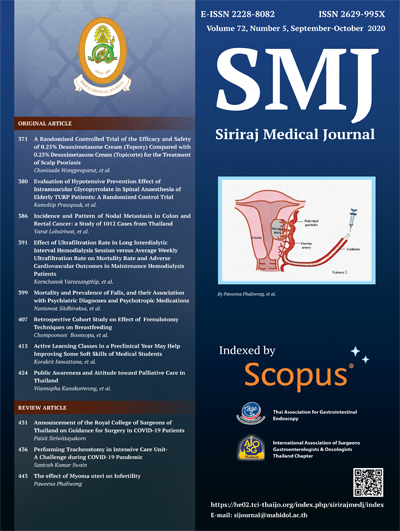Public Awareness and Attitude toward Palliative Care in Thailand
DOI:
https://doi.org/10.33192/Smj.2020.57Keywords:
end of life, palliative care, advance care planning, living willAbstract
Objective: This study aims to examine the Thai public’s awareness and attitude toward the end of life and palliative care.
Methods: We surveyed between February and April 2018. The sampling was framed by the Thailand National Statistical Office and used a stratified four-stage sampling. A total of 2,394 adults aged 20 to 80 years who had lived in one of nine provinces across all of Thailand for at least 3 months were interviewed with a questionnaire, which consisted of four parts.
Results: Thai culture and tradition were the main barriers to discuss the end of life preparation. Only 43% of the respondents, most of whom were elderly with chronic diseases, had concerned about the end of life. Most elderly respondents preferred to receive end-of-life care at home. Only 24% of respondents knew of palliative care. Most respondents believed that palliative care was provided in public hospitals. Most respondents (92%) were familiar with section 12 of the National Health Act., B.E. 2550, which states that a person has the right to refuse medical treatment; however, most (79%) had never heard of a living will and only 14% had experience of advance care planning.
Conclusion: Public awareness on the end of life preparation of Thai people was challenged and limited. The main barriers to concerns about it are attitude and knowledge. Promoting and educating palliative care is necessary as well as improve the availability of palliative care, both institutional and home-based care.
References
2. Davies E, Higginson I. The solid fact: Palliative care. [Online].; 2004 [cited 2016 July 28. Available from: www.euro.who.int/_data/assets/pdf_file/0003/98418/E82931.pdf?ua=1.
3. World Health Organization. Palliative care for noncommunicable diseases: a global snapshot in 2015. [Online].; 2018 [cited 2018 October 19. Available from: http://apps.who.int/iris/bitstream/handle/10665/206513/WHO_NMH_NVI_16.4_eng.pdf?sequence=1.
4. World Health Organization. Palliative Care. [Online].; 2018 [cited 2018 October 19. Available from: http://www.who.int/en/news-room/fact-sheets/detail/palliative-care.
5. World Health Organization. 10 facts on palliative care. [Online].; 2017 [cited 2018 October 19. Available from: http://www.who.int/features/factfiles/palliative-care/en/.
6. Anderson R, Grant L. What is the value of palliative care provision in low-resource settings? BMJ Global Health. 2017; 2: p. 1-3.
7. Groeneveld EI, Cassel JB, Bausewein C, Csikós Á, Krajnik M, Ryan K, et al. Funding models in palliative care: Lessons from international experience. Palliative Medicine. 2017; 31(4): p. 296–305.
8. Harris Interactive company. What Canadians Say: The Way Forward Survey Report. Ottawa:; 2013.
9. Hospis Malaysia. Palliative Care Need Assessment. Kuala Lumpur: Hospis Malaysia; 2016.
10. McIlfatrick S, Hasson F, McLaughlin D, Johnston G, Roulston A, Rutherford L, et al. Public awareness and attitudes toward palliative care in Northern Ireland. BMC Palliative Care. 2013; 12(34): p. 1-7.
11. MacLeod R, Thompson R, Fisher J, Mayo K, Newman N, Wilson D. New Zealanders' knowledge of palliative care and hospice services. N Z Med J. 2012 January; 20(125(1348):51-60.).
12. Cohen J, Pivodic L, Miccinesi G, Onwuteaka-Philipsen BD, Naylor WA, Wilson DM, et al. International study of the place of death of people with cancer: a population-level comparison of 14 countries across 4 continents using death certificate data. British Journal of Cancer. 2015;(113).
13. Neergaard MA, Jensen AB, Sondergaard J, Sokolowski I, Olesen F, Vedsted P. Preference for place‐of‐death among terminally ill cancer patients in Denmark. Scandinavian Journal Caring Sciences. 2011; 25(4): p. 627–636.
14. Gauthier G, Bernard E, Darrieux JC. End of life at home and preference for a place of death: a literature review. exercer. 2015; 26(118): p. 52-60.
15. Lynch T, Connor S, Clark D. Mapping Levels of Palliative Care Development: A Global Update. Journal of Pain and Symptom Management. 2013 June; 45(6).
16. Ministry of Public Health. Public Health Statistics 2015 Nonthaburi: Strategies and Planning Division; 2015.
17. The National Health Commission Office. National Health Act, B.E. 2550 (A.D. 2007). [Online].; 2017 [cited 2018 October 19. Available from: https://en.nationalhealth.or.th/wp-content/uploads/2017/11/HealthAct07.pdf.
18. The Australian Institute of Health and Welfare. Palliative care services in Australia. Canberra: The Australian Institute of Health and Welfare; 2013.
19. Chandoevwit W, Vajragupta Y. Long Term Care Insurance System: Long Term Care System for Thailand (in Thai). Bangkok: Thailand Development Research Institute (TDRI); 2017. Report No.: 978-616-92250-5-8.
20. World Health Organization. WHO Definition of Palliative Care. [Online].; 2018 [cited 2018 October 17. Available from: http://www.who.int/cancer/palliative/definition/en/.
21. The National Health Commission Office. Thai Living Will (in Thai). [Online].; n.a. [cited 2018 October 19. Available from: http://www.thailivingwill.in.th/.
22. Bosshard G, Fischer S, Bar W. Open regulation and practice in assisted dying: How Switzerland compares with the Netherlands and Oregon. Swiss Medical Weekly. 2002; 132: p. 527-534.
23. Nunes R, Rego G. Euthanasia: A Challenge to Medical Ethics. Journal of Clinical Research & Bioethics. 2016; 7(4).
24. Millintangkul U. National Policy on Palliative Care in Thailand. [Online].; 2015 [cited 2019 June 2. Available from: https://en.nationalhealth.or.th/wp-content/uploads/2017/11/NationalPolicyonPCare2015_09_17-1.pdf.
Downloads
Published
How to Cite
Issue
Section
License
Authors who publish with this journal agree to the following conditions:
Copyright Transfer
In submitting a manuscript, the authors acknowledge that the work will become the copyrighted property of Siriraj Medical Journal upon publication.
License
Articles are licensed under a Creative Commons Attribution-NonCommercial-NoDerivatives 4.0 International License (CC BY-NC-ND 4.0). This license allows for the sharing of the work for non-commercial purposes with proper attribution to the authors and the journal. However, it does not permit modifications or the creation of derivative works.
Sharing and Access
Authors are encouraged to share their article on their personal or institutional websites and through other non-commercial platforms. Doing so can increase readership and citations.















